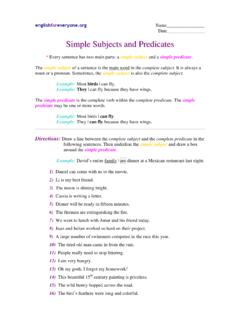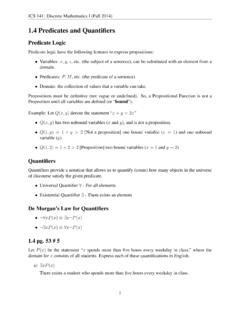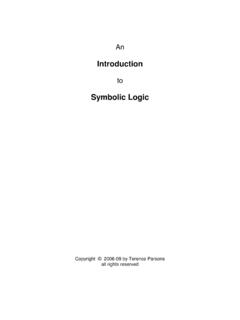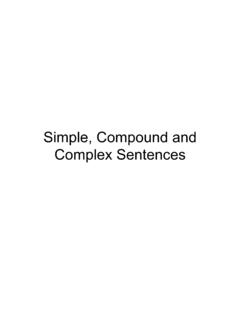Transcription of Grammar and Language Workbook - Language Arts 8 - Home
1 GLENCOELANGUAGEARTSG rammar and LanguageWorkbookGRADE8 Copyright by The McGraw-Hill Companies, Inc. All rights reserved. Except as permitted under the United StatesCopyright Act of 1976, no part of this publication may be reproduced or distributed in any form or means, or stored ina database or retrieval system, without the prior written permission of the all inquiries to:Glencoe/McGraw-Hill8787 Orion PlaceColumbus, Ohio 43240-4027 ISBN 0-07-820541-7 Printed in the United States of America2 3 4 5 6 7 8 9 10 066 03 02 01 00 Glencoe/McGraw-HillTable of ContentsiiiCopyright by Glencoe/McGraw-HillHandbook of Definitions and Rules ..1 Troubleshooter ..23 Part 1 Grammar ..45 Unit 1 Subjects, predicates , and of Sentences: Declarative andInterrogative .. of Sentences: Exclamatory Fragments .. and predicates : simple and predicates : Compound.
2 And Compound Sentences ..57 Unit 1 Review ..59 Cumulative Review ..60 Unit 2 : Proper and Common .. : Concrete and Abstract .. : Compounds, Plurals, and Possessives .. : Collective .. Plurals, Possessives, andContractions .. 2 Review ..73 Cumulative Review: Units 1-2 ..74 Unit 3 : Transitive and Intransitive .. with Indirect Objects .. Verbs and Predicate Words .. and Past Tenses .. Verbs and Helping Forms: Present Progressive and Past Tenses: Present and Past .. Future Time .. and Passive Voices .. Verbs Verbs II ..101 Unit 3 Review ..105 Cumulative Review: Units 1-3 ..106 Unit 4 : Personal .. and Antecedents .. Pronouns : Possessive and Indefinite .. : Reflexive and Intensive .. : Interrogative and Demonstrative ..117 Unit 4 Review ..119 Cumulative Review: Units 1-4 ..120 Unit 5 Adjectives and.
3 And Proper Adjectives .. and Superlative Adjectives .. and Superlative Adverbs .. Adverbs and Adjectives .. Avoiding Double Negatives ..135 Unit 5 Review ..137 Cumulative Review: Units 1-5 ..138 Unit 6 Prepositions, Conjunctions, and and Prepositional as Objects of Prepositions .. Phrases as Adjectives and Adverbs .. : Coordinating and Correlative .. Adverbs and Interjections ..149 Unit 6 Review ..151 Cumulative Review: Units 1-6 ..152 Unit 7 Clauses and Complex and Main Clauses .. Sentences and Subordinate Clauses .. and Nonessential Clauses .. 7 Review ..167 Cumulative Review: Units 1-7 ..168 Unit 8 and Participial Phrases .. and Gerund Phrases .. and Infinitive Phrases ..179 Unit 8 Review ..183 Cumulative Review: Units 1-8 ..184 Unit 9 Subject-Verb Subjects and Verbs Agree .. the Nouns and Other Special Subjects.
4 Pronouns as Subjects .. with Compound 9 Review ..197 Cumulative Review: Units 1-9 ..198 Unit 10 Diagraming Diagraming simple Subjects and predicates ..201 ContentsivGrammar and Language Workbook , Grade 8 Copyright by Diagraming Direct and Indirect Objects and Predicate Words .. Diagraming Adjectives and Adverbs .. Diagraming Prepositional Phrases .. Diagraming Compound Sentence Parts .. Diagraming Compound Sentences .. Diagraming Complex Sentences withAdjective or Adverb Clauses .. Diagraming Noun Diagraming Verbals .. Diagraming Infinitives ..219 Unit 10 Review ..221 Cumulative Review: Units 1-10 ..222 Part 2 Usage Glossary ..225 Unit 11 Usage Usage: accept to a Usage: beside to Usage: formally to Usage: leave to Usage: than to you 11 Review.
5 237 Cumulative Review: Units 1-11 ..238 Part 3 Mechanics ..241 Unit 12 Capitalization of Sentences, Quotations, and Salutations .. Capitalization of Names and Titles of Persons .. Capitalization of Names of Places .. Capitalization of Other Proper Nouns and 12 Review ..251 Cumulative Review: Units 1-12 ..252 Unit 13 Using the Period and Other End Using Commas to Signal Pause or Separation .. Using Commas with Clauses .. Using Commas with Titles, Addresses, and Dates .. Using Commas with Direct Quotes, inLetters, and for Clarity .. Using Semicolons and Colons .. Using Quotation Marks and Italics .. Using the Apostrophe .. Using the Hyphen, Dash, and Using Writing 13 Review ..277 Cumulative Review: Units 1-13 ..278 Part 4 Vocabulary and Spelling ..281 Unit 14 Vocabulary and Building Vocabulary: Learning from Building Vocabulary: Word Building Vocabulary: Prefixes and Building Vocabulary: Synonyms andAntonyms.
6 Building Vocabulary: Homographs andHomophones .. Basic Spelling Rules I .. Basic Spelling Rules II ..295 Review: Building Vocabulary ..297 Review: Basic Spelling Rules ..299 Part 5 15 The Writing Process: The Writing Process: The Writing Process: Revising .. The Writing Process: Editing .. The Writing Process: The Writing Process: Outlining .. Writing Effective Sentences .. Building Paragraphs .. Paragraph Ordering .. Personal Letters: Formal .. Personal Letters: Informal .. Business Letters: Letters of Request or of Complaint .. Business Letters: Stating Your Opinion ..341 Index ..343 TAE TestsUnit 1: Subjects, predicates , and 2: Nouns ..351 Unit 3: 4: Pronouns ..357 Unit 5: Adjectives and 6: Prepositions, Conjunctions, and Interjections ..361 Unit 7: Clauses and Complex Sentences.
7 365 Unit 8: 9: Subject-Verb Agreement ..371 Unit 10: Diagraming 11: Usage ..375 Unit 12: Capitalization ..377 Unit 13: Punctuation ..379 Unit 14: Vocabulary and Spelling ..381 Unit 15: Composition ..383 Answer Key ..387 Handbook1 Handbook ofDefinitionsand RulesHandbook3 Copyright by Glencoe/McGraw-HillHandbookSUBJECTS AND simple subjectis the key noun or pronoun that tells what the sentence is about. A compound subjectis made up of two or more simple subjects that are joined by aconjunction and have the same lantern and bugs fly simple predicateis the verb or verb phrase that expresses the essential thoughtabout the subject of the sentence. A compound predicateis made up of two or moreverbs or verb phrases that are joined by a conjunction and have the same jogged down the stretched and exercised for an complete subjectconsists of the simple subject and all the words that modify curly hairframed the child s soft glow of sunset made her complete predicateconsists of the simple predicate and all the words that modifyit or complete its ate a delicious muffin for apple muffin also contained the subject comes before the predicate in a sentence.
8 In inverted sentences, allor part of the predicate precedes the subject.(You) Waitfor me at the corner. (request)Through the toys raced the children. (inverted)Is the teacher feeling better? (question)There are seatsin the first OF singular nounis a word that names one person, place, thing, or plural nounnames more than one person, place, thing, or help you determine whether a word in a sentence is a noun, try adding it to thefollowing sentences. Nouns will fit in at least one of these sentences:He said something about know something about a(n) said something about know something about a common nounnames a general class of people, places, things, or proper nounspecifies a particular person, place, thing, event, or idea. Proper nounsare always AhabRomeMemorial DayTreasureIsland4 Grammar and Language Workbook , Grade 8 Copyright by concrete nounnames an object that occupies space or that can be recognized by anyof the abstract nounnames an idea, a quality, or a collective nounnames a group.
9 When the collective noun refers to the group as awhole, it is singular. When it refers to the individual group members, the collectivenoun is family eats dinner together every night. (singular)The council vote as they wish on the pay increase. (plural) possessive nounshows possession, ownership, or the relationship between two s bookthe rabbit s earsthe hamster s verb is a word that expresses action or a state of being and is necessary to make astatement. A verb will fit one or more of these sentences:He _____ sees action verbtells what someone or something does. The two types of action verbs aretransitive and intransitive. A transitive verbis followed by a word or words called thedirect object that answer the question what? or whom? An intransitive verbis notfollowed by a word that answers what? or whom?
10 Transitive: The tourists saw the janitor washed the : Owls hooted during the children played indirect object receives what the direct object sent her brothera linking verblinks, or joins, the subject of a sentence with an adjective or trucks were red. (adjective)She became an excellent swimmer. (nominative) verb phraseconsists of a main verb and all its auxiliary, or helping, had been toldof his are listeningto a have four principal partsor forms: base, past, present participle, and : I Participle: I am : I Participle:I have verbsform their past form and past participle by adding -edto the base by verbsform their past form and past participle without adding -ed to the PARTS OF IRREGULAR VERBSBase FormPast FormPast Participlebewas, werebeenbeatbeatbeatenbecomebecamebecome beginbeganbegunbitebitbitten or bitblowblewblownbreakbrokebrokenbringbro ughtbroughtcatchcaughtcaughtchoosechosec hosencomecamecomedodiddonedrawdrewdrawnd rinkdrankdrunkdrivedrovedriveneatateeate nfallfellfallenfeelfeltfeltfindfoundfoun dflyflewflownfreezefrozefrozengetgotgot or gottengivegavegivengowentgonegrowgrewgro wnhanghung or hung orhangedhangedhavehadhadknowknewknownlay laidlaidBase FormPast FormPast Participleleadledledlendlentlentlielayla inloselostlostputputputrideroderiddenrin grangrungriseroserisenrunranrunsaysaidsa idseesawseensetsetsetshrinkshrank orshrunk or shrunkshrunkensingsangsungsitsatsatspeak spokespokenspringsprang or principle parts are used to form six verb tenses.



